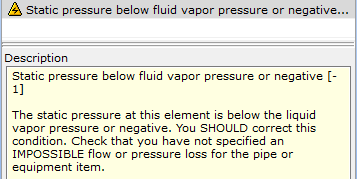This message is often indicative of a data-entry issue and every step should be taken to correct this issue in order to obtain more accurate results.

This warning can occur for a number of reasons as follows:
1. When a data-entry error/omission has occurred when entering node elevations. If we have a scenario where two nodes at different elevations are connected by a single pipe which is of insufficient length, this warning will be enunciated along with Pipe Length < Elevation Difference warnings.
The recommended approach is to correct the pipe length/node elevation data-entry and recalculate the model. You will notice that the Pipe Length < Elevation Difference warnings will now be eliminated and the "Static Pressure below fluid vapor pressure or negative" may also be eliminated unless there are other issues with the model. If the latter warning remains, please refer to the items outlined below.
2. When modelling piping flow systems, the continuity of energy must be upheld. As such, if the fluid velocity and associated velocity pressure (kinetic energy) in a pipeline or element has increased considerably, the static pressure may solve to a negative value. When this scenario arises, FluidFlow displays the warning: "Static Pressure below fluid vapor pressure or negative".
This scenario is often encountered in gas systems.
You may need to review the system design conditions (pipe diameters, design pressures and flow rates) in order to eliminate this warning message.
3. This warning can also occur in liquid systems where the user is attempting to develop too great a flow rate in a given system. It is recommended that the design flow rate is reduced to a level which allows the model to converge and reach an acceptable design solution.
4. This warning can occasionally be enunciated in large-scale systems which have been developed exclusively with Known Pressure nodes. When we model a system using this approach, the software will automatically determine the flow rates throughout the system. If however the design flow rate is known at any given inlet or outlet boundary in the system, try switching one Known Pressure node to a Known Flow node, enter the relevant design flow rate and recalculate to refresh the results. The system pressures
and flow rates will automatically be calculated, providing more accurate results and the warning may be eliminated.
Note, this methodology is more applicable to larger systems.
5. This warning may also be enunciated in a system if we have an operating scenario where a pipeline is not running full-bore with fluid, i.e., in vertical downstream lines with little or no back pressure and the fluid runs down the side walls of the pipe with vapor being sucked inwards to the pipe centerline (column separation). This tends to occur in systems with extreme differences in elevation or where there is discontinuity in the system elevations (see note 1 above).
A starting point is to check the node elevations and pipe lengths and recalculate the model once any corrections have been made. If the warning remains, try adding an orifice plate to the end of the vertical pipeline in question, adjusting the orifice size until such times as we develop enough back pressure and the warning is eliminated.
6. Finally, this condition can also arise if we have defined pipes with a length of zero (0 M).
7. This warning may occur if you have modeled a PD pump in series with a Known Flow node. By using these two nodes in series we are over constraining the model. The calculated flow rate developed by the PD pump is a function of engineering conditions (pipe diameter, length, etc.) and pump speed and cannot be manipulated by designating a Known Flow node. It is therefore best to model this scenario with known pressure nodes at the system boundaries and adjust the pump speed to reach the desired flow
rate in the pipelines.
Care should be taken to eliminate this warning in order to obtain accurate and meaningful results.